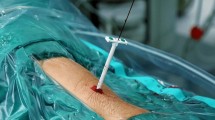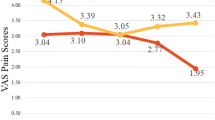Abstract
Purpose
To evaluate the effect of preoperative single-dose methylprednisolone use on postoperative early pain after retrograde intrarenal surgery (RIRS).
Methods
Patients who had 10–20 mm solitary kidney stones and underwent RIRS procedures were included in this prospective cohort study between February 2022 and May 2023. Patients who were administered methylprednisolone at a dose of 1 mg/kg preoperatively were included in group 1 (n: 31), and the other first 90 patients who met the inclusion criteria and did not receive methylprednisolone before surgery were included in group 2 (n: 90). Demographic data, features of stone, postoperative pain at 1, 6, 12, 18, and 24 hour, the need for analgesics, changes in serum glucose levels, and the prevalence of postoperative fever were compared.
Results
Age, sex, stone laterality, localization, size, Hounsfield Unit, modified Satava scores, stone-free status, duration of the RIRS procedure, and duration of the ureteral access sheath were found to be similar between groups. Visual Analog Scale (VAS) scores at postoperative 1, 6, 12, 18, and 24 h were found to be statistically significantly lower in group 1 (p = .001, p = .001, p = .001, p = .001, and p = .001, respectively). Similarly, postoperative analgesic requirements were found to be significantly lower in group 1 (p = .048) with a similar postoperative fever rate and changes in serum glucose levels between groups.
Conclusion
Giving a single dose of methylprednisolone at a dose of 1 mg/kg preoperatively for the RIRS procedure is safe and effective at preventing early pain and the need for analgesics after the RIRS procedure.
Similar content being viewed by others
Data availability statement
The dataset used and analyzed during the current study are available from the corresponding author on reasonable request.
References
Wendt-Nordahl G, Mut T, Krombach P et al (2011) Do new generation flexible ureterorenoscopes offer a higher treatment success than their predecessors? Urol Res 39:185–188
Oğuz U, Şahin T, Şenocak Ç et al (2017) Factors associated with postoperative pain after retrograde intrarenal surgery for kidney stones. Turkish J Urol 43(3):303
Torricelli FC, De S, Hinck B et al (2014) Flexible ureteroscopy with a ureteral access sheath: when to stent? Urology 83(2):278–281
Pulitano C, Aldrighetti L (2008) The protective role of steroids in ischemia-reperfusion injury of the liver. Curr Pharm Des 14(5):496–503
Romundstad L, Stubhaug A (2007) Glucocorticoids for acute and persistent postoperative neuropathic pain: what is the evidence? J Am Soc Anesthesiol 107(3):371–373
Zhuo Y, Yu R, Wu C et al (2021) The role of perioperative intravenous low-dose dexamethasone in rapid recovery after total knee arthroplasty: a meta-analysis. J Int Med Res 49(3):0300060521998220
Holte K, Kehlet H (2002) Perioperative single-dose glucocorticoid administration: pathophysiologic effects and clinical implications. J Am Coll Surg 195(5):694–712
Oguz U, Resorlu B, Ozyuvali E et al (2014) Categorizing intraoperative complications of retrograde intrarenal surgery. Urol Int 92(2):164–168
Mathew G, Agha R, Albrecht J et al (2021) STROCSS 2021: strengthening the reporting of cohort, cross-sectional and case-control studies in surgery. Int J Surg Open 37:100430
Tepeler A, Resorlu B, Sahin T et al (2014) Categorization of intraoperative ureteroscopy complications using modified Satava classification system. World J Urol 32:131–136
Price DD, McGrath PA, Rafii A et al (1983) The validation of visual analogue scales as ratio scale measures for chronic and experimental pain. Pain 17(1):45–56
Matlaga BR, Assimos DG (2002) Changing indications of open stone surgery. Urology 59(4):490–493
Alcaide JRC, De La Peña BJ (2010) Flexible ureterorenoscopy (URS): technique and results. Arch Esp Urol 63(10):862–870
Singh BP, Prakash J, Sankhwar SN et al (2014) Retrograde intrarenal surgery vs extracorporeal shock wave lithotripsy for intermediate size inferior pole calculi: a prospective assessment of objective and subjective outcomes. Urology 83(5):1016–1022
Pedersen KV, Olesen AE, Osther PJS et al (2013) Prediction of postoperative pain after percutaneous nephrolithotomy: can preoperative experimental pain assessment identify patients at risk? Urolithiasis 41:169–177
Zargar-Shoshtari K, Anderson W, Rice M (2015) Role of emergency ureteroscopy in the management of ureteric stones: analysis of 394 cases. BJU Int 115(6):946–950
Hawken SR, Hiller SC, Daignault-Newton S et al (2021) Opioid-free discharge is not associated with increased unplanned healthcare encounters after ureteroscopy: results from a statewide quality improvement collaborative. Urology 158:57–65
Damar E, Senocak C, Ozbek R et al (2022) Does ureteral access sheath affect the outcomes of retrograde intrarenal surgery: a prospective study. Minim Invas Ther All Technol 31(5):777–781
Inoue T, Hamamoto S, Okada S et al (2022) Evaluating predictive factor of systemic inflammatory response syndrome and postoperative pain in patients without ureteral stent placement after ureteral access sheath use in flexible ureteroscopy for stone management. J Endourol 36(2):169–175
Tanrıverdi O, Yencilek F, Koyuncu H (2011) Emergent stenting after uncomplicated ureteroscopy. Urology 77:305–308
Byrne RR, Auge BK, Kourambas J et al (2002) Routine ureteral stenting is not necessary after ureteroscopy and ureteropyeloscopy: a randomized trial. J Endourol 16(1):9–13
Sapolsky RM, Romero LM, Munck AU (2000) How do glucocorticoids influence stress responses? Integrating permissive, suppressive, stimulatory, and preparative actions. Endocr Rev 21(1):55–89
Hai H-H, Aw P, Teng TZJ et al (2021) Perioperative steroid administration reduces overall complications in patients undergoing liver resection: a meta-analysis. World J Gastrointest Surg 13(9):1079
Koc S, Gürbüzler L, Yaman H et al (2011) The effectiveness of steroids for edema, ecchymosis, and intraoperative bleeding in rhinoplasty. Am J Rhinol Allergy 25(2):e95–e98
Hamidi N, Ozturk E, Yikilmaz TN et al (2018) The effect of corticosteroid on postoperative early pain, renal colic and total analgesic consumption after uncomplicated and unstented ureteroscopy: a matched-pair analysis. World J Urol 36:979–984
Baker RC, Armstrong MA, Young IS et al (2006) Methylprednisolone increases urinary nitrate concentrations and reduces subclinical renal injury during infrarenal aortic ischemia reperfusion. Ann Surg 244(5):821
Kim J-K, Lee H-J, Park J-Y et al (2020) Efficacy of systemic steroid use given one day after total knee arthroplasty for pain and nausea: a randomized controlled study. J Arthroplasty 35(1):69–75
Wan S, DeSmet J-M, Antoine M et al (1996) Steroid administration in heart and heart—lung transplantation: is the timing adequate? Ann Thorac Surg 61(2):674–678
Fu X, Ye X, An L-N et al (2023) Efficacy and safety of methylprednisolone for lung surgery: a systematic review and meta-analysis of randomized controlled trials. Pain Ther 12(1):165–186
Grijalva CG, Chen L, Delzell E et al (2011) Initiation of tumor necrosis factor-α antagonists and the risk of hospitalization for infection in patients with autoimmune diseases. JAMA 306(21):2331–2339
Funding
The authors declare that they have no relevant financial interests.
Author information
Authors and Affiliations
Contributions
ETK: corresponding author, protocol and project development, data analysis, and manuscript writing. MB: project development, data analysis, and manuscript writing. MŞ: project development, data analysis, and manuscript writing. HÖ: project development, manuscript writing and editing. ÇŞ: project development, data analysis. HLC: project development and editing.
Corresponding author
Ethics declarations
Conflict of interest
The authors declare that they have no conflict of interest.
Ethical approval for research involving human participants
The study was approved by the local ethics committee (Institutional Review Board approval no: KAEK/2022.01.18) at University of Health Sciences Basaksehir Cam and Sakura City Hospital. All procedures performed in our study involving human participants were in accordance with the ethical standards of the institutional and national research committee and with the 1964 Helsinki Declaration and its later amendments or comparable ethical standards and this study was designed according to the STROCSS 2021 criteria.
Additional information
Publisher's Note
Springer Nature remains neutral with regard to jurisdictional claims in published maps and institutional affiliations.
Rights and permissions
Springer Nature or its licensor (e.g. a society or other partner) holds exclusive rights to this article under a publishing agreement with the author(s) or other rightsholder(s); author self-archiving of the accepted manuscript version of this article is solely governed by the terms of such publishing agreement and applicable law.
About this article
Cite this article
Keskin, E.T., Bozkurt, M., Şahin, M. et al. Effect of preoperative single-dose methylprednisolone administration on early postoperative pain following retrograde intrarenal surgery. Int Urol Nephrol 56, 1253–1258 (2024). https://doi.org/10.1007/s11255-023-03875-9
Received:
Accepted:
Published:
Issue Date:
DOI: https://doi.org/10.1007/s11255-023-03875-9




